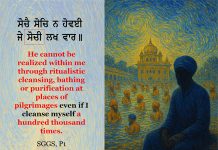
By Gurnam Singh | Opinion |
In the minds of most, Sikh or non-Sikh, 1984 will go down as a line in the sand of the history of modern India. From June to November of that year it would not be an overstatement that the Indian state and the ruling Congress Party declared a de facto war on Sikhs resulting in the deaths of thousands. But this is not new; hardships and genocidal violence are etched into Sikh history. Indeed, it is difficult to imagine Sikh identity and psyche without reference to the historic genocide the quam has periodically experienced.
In 1746 we had the first genocide called the Chhota Ghallughara (Small Holocaust). This massacre of Sikhs, that happens over the course of a couple of days, was committed under the rule of Afghan invader Ahmad Shah Durrani. Thousands were killed, and many historical Sikh sites were destroyed. Some 16 years later, in 1762, we saw the second Genocide known as the ‘Wadda Ghallughara (Great Holocaust)’. As the name suggests, this was an even more devastating massacre carried out by Afghan forces. It resulted in the death of tens of thousands of Sikhs, including women and children. Now given that the Sikh population was probably less than 100,000, this massacre effectively wiped out a significant proportion of the Sikh Quam. Click here for stories on Sikh Genocide.
Notwithstanding the deaths of 100,000’s of Sikhs in the 1947 partition of Punjab, the next recoded Sikh Genocide took place in June 1984 during that is infamously known as Operation Blue Star. From the 1st June onwards the Indian government launched a military operation in the Punjab centred on the Darbar Sahib or Golden Temple complex in Amritsar. The operation resulted in heavy casualties and significant damage to the temple. This event led to widespread Indian military operations in Punjab resulting in the deaths of thousands of Sikhs for a whole decade to come.
And then in November 1984, we saw the fourth Sikh Genocide. This occurred following the assassination of the then Indian Prime Minister, Indira Gandhi by her Sikh bodyguards. Led by Congress party politicians and workers, we saw three days of anti-Sikh violence centred mostly on Delhi and other major Indian cities of India. Innocent Sikh men, women and children were targeted, and widespread violence, arson, and killings took place. The exact death toll is disputed, but estimates range from several thousand to over 20,000 Sikhs killed.
These genocidal events have had a profound impact on the Sikh community and psyche, leading to the loss of countless lives, the destruction of religious sites, and an enduring trauma for Sikhs around the world. Perhaps the most enduring impact has been for generations of Sikhs expressing a desire to break free from the centralising Indian state under which they perceive an existential threat.
Though the demand for Khalistan, an independent Sikh state was not new, the events of 1984 turbocharged this demand culminating in a historic Sarbat Khalsa or gathering of the Khalsa Panth to deliberate on the future direction of the quom on 26th January 1986. During the gathering at the Akaal Takht in Amritsar of over half million Sikhs, amongst the various resolutions was the formal presentation of a legal case the establishment of the Khalistan. This was done in the form of the presentation of a dossier of legal evidence setting out the case for Khalistan along with a resolution to appoint a committee of 5 Sikhs to work towards its realization. Thirty seven years after the historic Sarbat Khalsa, Sikhs throughout the world still actively campaign to realise their dream of their own homeland. However, most objective assessments suggest the realisation of Khalistan remains as elusive as ever.
As we saw with the phenomenal rise of youth leaders Amritpal Singh and his Khalsa Vaheer, and the worldwide success of the Punjab Referendum campaign, there is a latent urge for Khalistan. However, it is also true that, politically and electorally, most significantly, in the Punjab, it has not made much of an impression. However, in some sense we are at a stalemate and though some attempts have been made to broker an agreement between Khalistani activists and the Indian state, due to a lack of trust and good will, these have not led to any substantial improvement of relations.
Now that the 40 anniversary of the 1984 Sikh Genocide approaches, we have opportunity to focus hearts and minds on finding a solution to the ongoing and arguably unhelpful fall out from those terrible events. However, closure will only be possible if Sikhs feel a real sense of justice and the Indian state shifts from its rhetoric about being ‘pro-Sikh’ to addressing the serious and legitimate demands of Sikhs. And only then can we hope for a successful peace and reconciliation process. In order to move forward, it incumbent on both sides to see the other perspective.
ARGUMENTS BY PROPONENTS
So, from the perspective of advocates of Khalistan, there is a need to acknowledge the arguments put forth by proponents of the movement. These can be summarised as follows:
Self-determination: One of the primary arguments for Khalistan is based on the principle of self-determination. Supporters argue that Sikhs, as a distinct religious and cultural community, have the right to determine their own political destiny. They believe that the creation of an independent Sikh state would allow Sikhs to govern themselves and protect their unique identity and interests.
Historical and cultural significance: Proponents of Khalistan often emphasize the historical and cultural significance of Punjab as the traditional homeland of the Sikhs. They argue that the region holds immense religious and cultural importance for Sikhs and that an independent Sikh state would serve as a symbol of Sikh sovereignty and heritage.
Political marginalization and discrimination: Some Khalistan supporters argue that Sikhs have faced political marginalization and discrimination within the Indian state. They point to instances such as the Operation Blue Star in 1984, which was a military operation conducted by the Indian government to remove Sikh militants from the Golden Temple complex, resulting in significant casualties and damage. They believe that an independent Khalistan would protect Sikhs from such injustices and provide a platform for their political empowerment.
Protection of Sikh interests: Supporters of Khalistan assert that an independent Sikh state would enable Sikhs to safeguard their religious, economic, and cultural interests more effectively. They argue that being a minority in India, Sikhs often face challenges in preserving their distinct identity and securing their rights. Khalistan, they claim, would provide a dedicated space for Sikhs to promote and protect their interests without being overshadowed by the dominant Hindu majority.
Autonomy and governance: Another argument put forth by Khalistan proponents is that an independent Sikh state would allow Sikhs to govern themselves according to their own values, traditions, and principles. They believe that self-governance would enable them to address issues specific to their community effectively and make decisions that align with Sikh religious and cultural norms.
COMPLEX, CONTENTIOUS
It is important to note that the demand for Khalistan is a complex and contentious issue and that not all support the idea, and others may have reservations or outright oppose it. That, however, does not take away the right to make the case and campaign for self-determination in a peaceful and democratic way. Indeed ,this is a right that is specifically protected in International Covenant on Civil and Political Rights (the ICCPR), ‘[a]ll peoples have the right of self-determination. By virtue of that right they freely determine their political status and freely pursue their economic, social and cultural development.’
No peace and reconciliation process can suggest without taking seriously the arguments on both sides. And in this regard the Indian state has its own defence which is centred on its duty to protect unity and stability of the state. It has accordingly taken actions to suppress the Khalistan movement as a conspiracy by is neighbour and historic enemy Pakistan to destabilise the state.
OPPOSING ARGUMENTS
For any table talk to happen and a successful outcome, advocates of Khalistan will have to develop a robust response to the arguments that the Indian state will make opposing the idea of an independent Sikh state. Here is a brief summary of the key anti-Khalistan arguments:
Sovereignty and territorial integrity: Critics argue that Punjab is an integral part of India and that advocating for Khalistan undermines the country’s sovereignty and territorial integrity. They believe that supporting secessionist movements sets a dangerous precedent that could encourage other separatist demands, potentially leading to fragmentation and instability within the country.
National unity and diversity: Opponents of Khalistan contend that India’s strength lies in its unity and diversity. They argue that embracing diversity while maintaining a unified nation is a cornerstone of India’s identity as a multicultural and multi-religious society. Dividing the country along ethnic or religious lines, they assert, would undermine this unity and disrupt the social fabric.
Economic implications: Critics of Khalistan suggest that the creation of an independent Sikh state would have significant economic consequences, both for Punjab and the wider region. They argue that Punjab, which is currently one of India’s prosperous states, benefits from being part of the Indian Union and its integration into the national economy. Separation, they claim, could disrupt trade, investment, and economic development, potentially leading to adverse effects on the livelihoods of the people in the region.
Security concerns: Detractors express concerns about the potential security implications of an independent Khalistan. They argue that the formation of a new state might trigger unrest, conflicts, and border disputes, leading to instability not only in Punjab but also in neighbouring regions. Additionally, opponents worry about the potential for external interference and the rise of militant or extremist elements within the proposed Khalistan.
Inclusivity and minority rights: Critics contend that advocating for a separate Sikh state may undermine the principles of inclusivity and minority rights within India. They argue that rather than pursuing separatism, it is essential to work towards fostering a more inclusive society where all communities, including Sikhs, have equal opportunities, representation, and protection of their rights.
One of the lessons of history is that the future is difficult to predict. In this regard, given the instability of post-partition India and Pakistan, the question of Khalistan may take on a whole different dimension if one or both state collapses. One needs to look no further than the collapse of the Soviet Union, and let’s not forget, India itself was established as a union of states, and in this regard, its legitimacy is predicated on the social contract established between its people, its various nations, and the union government in Delhi.
In truth, countries come and go, empires rise and fall, and in this regard, perhaps most of all, Sikhs need to reflect from their own history when indeed, under the leadership of the benevolent rulers, Ranjit Singh, they once did have their own sovereign rule. And as for breaking the current stalemate, it seems to me the only option is for Sikhs to open dialogue with the Indian state to establish a process of normalise relations and to work towards peace, reconciliation and justice. This does not mean the dream of Khalistan is abandoned, but it does mean working much harder at articulating a democratic roadmap for its realisation.

Gurnam Singh is an academic activist dedicated to human rights, liberty, equality, social and environmental justice. He is an Associate Professor of Sociology at University of Warwick, UK. He can be contacted at Gurnam.singh.1@warwick.ac.uk
* This is the opinion of the writer and does not necessarily represent the views of Asia Samachar.
RELATED STORY:
Miracles and Godmen (Asia Samachar, 31 July 2020)
ASIA SAMACHAR is an online newspaper for Sikhs / Punjabis in Southeast Asia and beyond. When you leave a comment at the bottom of this article, it takes time to appear as it is moderated by human being. Unless it is offensive or libelous, it should appear. You can also comment at Facebook, Twitter, and Instagram. You can reach us via WhatsApp +6017-335-1399 or email: asia.samachar@gmail.com. For obituary announcements, click here.
































